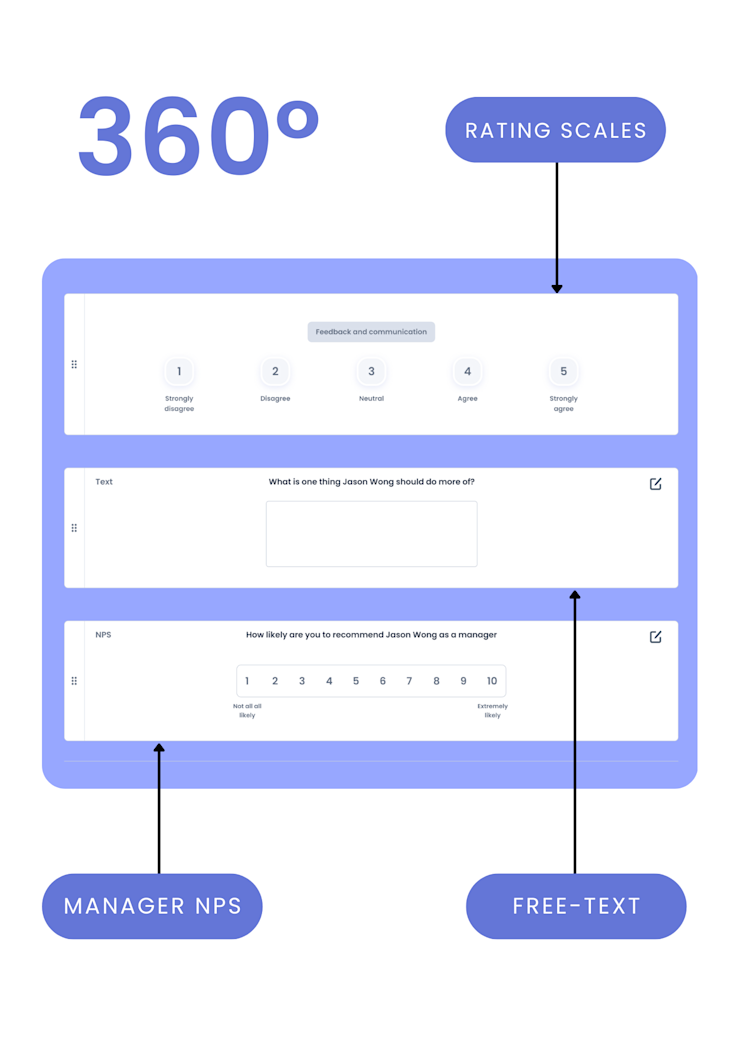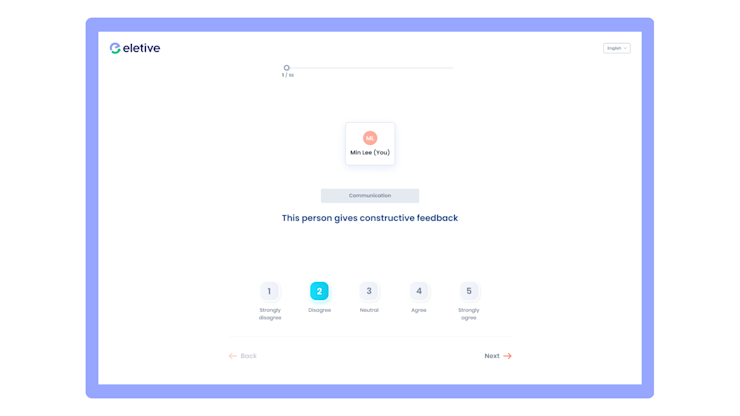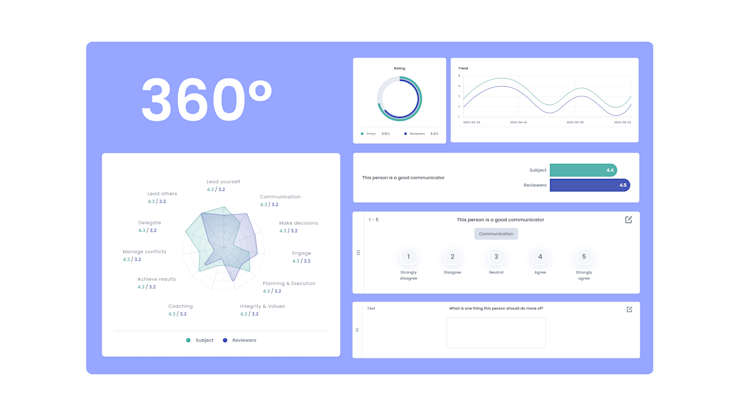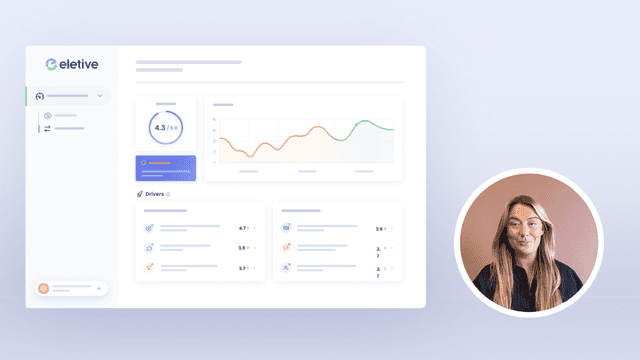360-degree feedback is a powerful tool for professional development and for improving the employee experience. In this guide, we look closely at the ins and outs of peer feedback, and share best practices for leveraging 360-feedback in your organisation.
85% of Fortune 500 companies use 360 degree feedback to reduce bias and get holistic reports.
360 surveys are a powerful tool for professional development, and also for personal development.
In this article, we'll discuss how to give 360 feedback in a constructive way. We’ll also give you some friendly sample questions that’ll kickstart your review process.
What is 360-degree feedback?
360-degree feedback or simply, 360 feedback is a holistic performance review system that includes feedback from bosses, peers, and subordinates to create a comprehensive performance report.
It highlights employee strengths, clarifies weaknesses, incorporates different points of view, and does all of these anonymously.
What are the benefits of 360-degree feedback?
As much as it helps leaders to improve themselves, 360-degree feedback also helps employees be at their productive best. According to an OfficeVibe study, 65% of working professionals want more feedback from their managers. For employees, 360 feedback benefits include:
Improved communication: 360 degree feedback encourages open and honest communication among employees, managers and peers.
Increased motivation: As individuals receive feedback from a variety of sources, they are more likely to feel valued and motivated by their peers. It can also boost morale.
Improved self-awareness: 360 degree appraisals provide individuals with a comprehensive picture of their performance across a range of criteria, allowing them to identify their strengths and weaknesses.
Increased employee engagement: 360 degree feedback encourages employees to be more engaged in the workplace, as they have a greater understanding of how their performance affects the team.
Improved team performance: 360 degree feedback provides an opportunity for teams to discuss and identify areas of strength and weakness, improving team performance.
Enhanced employee development: Individuals can use the feedback to develop an action plan for improvement, target specific areas for development, and measure progress.
Identifying skill gaps: weaknesses can be addressed in a meaningful way and employees can operate on a transparent and level playing field
Tips for providing constructive 360 degree feedback (how to do it right)
1.Foster a positive feedback culture
Promoting dialogue and inviting employees to give their thoughts and ideas in a positive way are key for forming an effective feedback culture.
By creating an environment where individuals feel comfortable providing honest input without fear of retaliation or negative consequences, organisations can harness the full potential of 360-degree feedback.
Leveraging Eletive’s suite of performance management tools is an easy way to show employees that you are committed to fostering a collaborative work environment that values continuous improvement.
2. Focus on actionable insights
Providing vague statements is a waste of everyone's time.
Aim to give concrete feedback that highlights particular instances where improvements can be made.
This helps individuals understand exactly what they need to work on moving forward.
Wrong:
"You're not a great leader"
"You need to improve your communication skills"
“Your UX and UI knowledge is really limited”
Right:
Point out specific situations where leadership skills were lacking
Mention a particular meeting or email exchange where the person's communication was unclear or ineffective
Provide links to helpful online resources and bootcamps where they can read up
3. Offer praise and recognition
By acknowledging others accomplishments and positive traits, you not only boost their morale but also encourage people to continue excelling in those areas.
To give meaningful praise during a 360-degree feedback session, focus on specific examples where your colleagues have demonstrated exceptional skills or qualities.
Some common attributes worth highlighting include:
Effective communication with team members
Maintaining calm under pressure
An eye for detail and accuracy in work output
A willingness to help others when needed
Innovative problem-solving abilities
Tailor your compliments by considering each individual's unique contributions to the team and organisation as a whole.
4. Address areas for improvement tactfully
It’s essential to not only give praise but also address any potential weaknesses tactfully so as to foster growth among staff members.
Differentiating between constructive criticism and negative feedback is essential.
Constructive criticism focuses on the behaviour or performance issue at hand, rather than attacking the person directly.
It should be solution-oriented and aim to help individuals grow professionally by identifying areas for improvement.
Negative feedback: "You always miss deadlines."
Constructive criticism: "I've noticed that some of your projects have been delayed recently. Let's discuss strategies for better time management and prioritisation."
You can also encourage a growth mindset through your constructive feedback in three steps:
Acknowledge the effort: Recognize the hard work put in by your colleague, even if their performance didn't meet expectations entirely.
Suggest specific improvements: Offer clear recommendations based on observed behaviours or outcomes that could lead to better results in future tasks.
Provide resources: Share relevant articles, tools, or training opportunities that can help your coworker develop the skills needed to excel in their role.
5. Write concise and objective feedback
When participating in a 360-review process, it's essential for employees to provide concise, detailed, and objective feedback.
This ensures that everyone involved receives valuable information without being overwhelmed by lengthy responses or vague statements.
Try to incorporate the following:
Use simple language without jargon or abbreviations.
Balance your tone by highlighting both strengths and areas for improvement.
Edit your review to ensure clarity and coherence, removing any unnecessary words or phrases.
And to keep your feedback objective:
Make sure you avoid biases like recency, halo, and confirmation bias
Try and use facts and examples instead of personal opinions
Avoid comparisons with other team members
6. Utilise 360-degree feedback software
Benefits of Using Specialized Software for Collecting Feedback:
Efficiency: With a centralised platform, HR managers can easily manage the entire feedback process, from sending out questionnaires to analysing results.
User-friendly interface: A well-designed software solution makes it easy for employees to navigate and complete their evaluations quickly.
Data analysis: Advanced analytics features help organisations identify trends, strengths, and areas needing improvement across teams or departments.
Actionable insights: By visualising data in real-time dashboards or reports, decision-makers can make informed decisions about employee development initiatives based on accurate information.
Anonymity: Employees are more likely to provide honest input if they know their responses will remain anonymous.

Eletive’s 360 degree feedback feature helps you automate the entire 360-degree feedback process.
Our platform minimises administration, and aggregates individual results for an organisational overview. Making it a powerful tool for creating a culture of continuous learning and development.
Now that we’ve given you our top tips, it’s time to move on to some specific scenarios. We’re going to show you how to give 360 feedback to your boss, peers and employees…
How to give 360 feedback to your boss
When giving 360 feedback to your boss, you don't simply offer feedback—you deal with egos, relationship complexities, and career prospects. It's important to be honest yet diplomatic. If referencing an incident, do not provide ancillary information that is not needed and if possible, provide a solution to a problem as well.
360 feedback examples for managers
1. Appreciating their help
Last week when I was struggling to close the lead over call. X took over, calmed the prospect down, closed the deal, and later explained to me what needs to be done in such situations. I appreciate how X handled the situation and gave me the confidence to move on to the next one.
2. Pointing out a flaw
I understand X is under a lot of pressure lately but we have made some real progress regarding the website architecture. We rarely brainstorm ideas together these days and it would be great if X can schedule 1:1 huddles with team members to review work at least once a week.
How to give 360 feedback to your peers
Peer appraisals are a different beast. Many employees feel torn between being an honest friend and a critic. It's important to be honest yet kind and to remember that constructive feedback is valuable to the recipient. Be thoughtful about your wording and use a professional tone to help them gauge their performance.
360 feedback examples for peers
1. Highlighting a strong point
X has incredible communication skills and often helps other team members to resolve communication issues. It has improved our workflow and productivity. Last week X stayed late to help a couple of us in the meeting and closed a new client.
2. Pointing out a weakness
X is very tolerant of errors when a project is handed over to him. While a certain degree of errors is expected, he'll reach new heights in his career with a more detail-oriented and thorough approach.
3. Appreciating job knowledge
X has a solid knowledge of key job responsibilities that has helped our team deliver quality work on a day-to-day basis. The fact that X often acts as a subject matter expert on new topics is greatly appreciated.
How to give 360 feedback to employees
When bosses give 360 feedback to employees, it's important to balance the positives with negatives and offer an encouraging view vis-a-vis the job responsibilities of the employee. A constructive and encouraging approach, emphasising strengths and pointing out opportunities for improvement in an empathetic way, will leave ideally employees feeling seen, validated, and inspired.
360 feedback examples for employees
1. Point out the wins
Last week, X's work under pressure stood out for me. The way X handled the data breach and fixed the SQL query was an example for the entire team. Great job finishing the project before the deadline.
2. Show how they can improve
X's overall performance and contribution would benefit from better responsiveness and communication from X. An effort to respond to urgent emails quicker will help the team plan better.
3. Highlight their potential
X has great leadership skills that are often visible when their team is under the pump. X stays calm, communicates with their peers, and has an eye for details.
In the next section, we’re going to give you some closed and open example 360-degree feedback questions.
You’ll be able to implement them fast, or simply use them as inspiration.

Closed 360-degree feedback questions [Examples]
Closed questions, which means questions where the respondents choose between the options of "strongly disagree," "disagree," "neutral," "agree," and "strongly agree," are great to include in your 360-degree feedback review. Closed-ended questions enable quantifiable analysis and help you track changes over time.
Examples of 360-degree feedback questions include:
[Name] is good at prioritising their workload and meeting deadlines.
[Name] communicates clearly and efficiently with other coworkers and me.
[Name] has strong leadership skills and is a good leader.
[Name] exhibits strong interpersonal skills and helps people feel welcome and at ease.
[Name] provides timely and clear feedback.
[Name] prioritises teamwork and puts the team first.
[Name] takes the initiative in problem-solving and is solution-oriented.
[Name] is open to receiving feedback, both when it's negative and positive.
[Name] embodies our company culture and values.
[Name] values different perspectives and welcomes diverse opinions.
Open-ended 360-degree feedback questions [Examples]
To get more qualitative information, including open-ended questions in your 360-degree feedback is also essential. These questions should focus both on an employee's strengths and their areas for improvement. This will help ensure that each 360-degree review includes a balance of positive and constructive feedback.
Examples of open-ended 360-degree feedback questions include:
What would you say are the strengths of [Name]?
What is one thing [Name] should do more?
What is one thing [Name] should continue doing?
What is one thing [Name] should stop doing?
How well would you say [Name] manages their time and workload?
Can you share an example of a company value that [Name] has brought to life?
What three words would you use to describe [Name]?
[For leadership roles] If you were [Name], what would be the first thing you would do?
How well does [Name] adapt when priorities change?
Can you name an area where you'd like to see [Name] improve?
5 things to keep in mind
Several factors play into the effectiveness and usefulness of feedback questions. The type, length, timing, frequency, phrasing, and structure can all impact how well participants receive them. That's why it is essential to choose carefully when designing these types of surveys for your organisation, and when choosing a 360 feedback tool.
An organised and structured approach to peer feedback is necessary if employees are to develop from the feedback over the long term. A 360° feedback tool enables HR and managers to create actionable feedback loops, to increase engagement and productivity in the workplace.
1. The purpose is to evolve, not to be evaluated
During the 360° feedback process, it's essential that the employees understand and feel like the goal is to evolve, rather than be evaluated.
Otherwise, the feedback can cause stress.
Remember: 360° feedback tools should be employee-centric and take other things than numbers into account, which is what makes them very different from regular performance measurement tools.
2. Focus on strengths and opportunities
When thinking of employee development, it's a common mistake to start pointing out all the negatives you'd like to see removed.
Instead, focus on the positive aspects of the employee, and try to reproduce the productive behaviour.
However, there is always room for growth, both on an individual and organisational level. Combining questions about the employee's strengths with questions about areas where they can grow and evolve, will help you avoid scenarios where people feel overwhelmed or unfairly assessed.
3. It's all about the employee
Self-leading individuals who take responsibility for their growth and career development are every employer's dream. Allowing employees to take their own initiative and receive feedback whenever they want, from whomever they want, is empowering. That's why it's essential for 360-degree surveys to be employee-centric.
4. Numbers are important, but not everything
Moving beyond numbers is vital to achieving actual change from the feedback given to the employee.
Many factors in the workplace aren't quantifiable, at least not in a way that makes employees feel motivated.
Instead, your 360 feedback tool is a great complement to other performance appraisal methods, as it adds the qualitative and interpersonal aspects of performance.
5. Effective surveys keep the employee engaged
Although often neglected, the length of your survey has a big impact on its effectiveness. If it's too long, people may not put the same effort into each answer.
It can also be challenging for the person being reviewed to handle too much data. It's usually best to keep your 360 surveys short and sweet, focusing on the most important questions.
For more information about which style might best suit your needs or how we could help you with this process, please reach out to our team.

What to do after receiving 360-degree feedback?
After receiving 360-degree feedback, it's essential for individuals to reflect on the input provided and create an action plan for implementing changes or improvements in their performance.
This demonstrates a commitment to personal growth and enhances overall team dynamics.
Step 1: Analyse received feedback objectively
Embrace different perspectives with an open mind to maximise the value of 360-degree feedback and leverage it as a learning opportunity.
Do not let constructive criticism affect your self-esteem; rather, use it to identify areas of improvement and grow professionally. Instead, use this opportunity to learn from others' insights and identify areas where you can grow professionally.
Review each piece of feedback carefully and look for recurring themes or patterns.
Acknowledge both positive comments as well as suggestions for improvement.
Consider discussing your findings with a trusted colleague or mentor who can provide additional guidance.
Step 2: Create actionable steps for improvement
The next step is developing a concrete plan to address identified areas of development based on the received 360-feedback.
By setting specific goals, you'll be able to track progress over time while also demonstrating your commitment towards self-improvement within the workplace:
Prioritise key areas of improvement by considering their impact on your job performance and professional growth potential.
Create SMART (Specific, Measurable, Achievable, Relevant, Time-bound) objectives that outline how you will tackle these challenges head-on. Note: For more information about SMART goals, check out this helpful resource.
Develop a timeline for achieving your goals, including milestones and deadlines to keep yourself accountable.
Consider seeking additional resources or support, such as professional development courses or mentorship opportunities within your organisation.
Incorporating the feedback you've received from your 360-degree evaluation into an actionable plan is crucial for driving personal growth and enhancing team dynamics. Embracing feedback and striving to grow will aid you in becoming a more productive worker, thus aiding the organisation's success.
Conclusion
There you have it!
Our complete rundown on 360-degree performance reviews. Use our tips to improve your processes and give better feedback to your peers.
We’re here to support you on your performance management journey.
So if you’d like to discover how Eletive can help you collect feedback more effectively, then book a demo here.

























